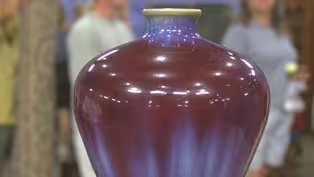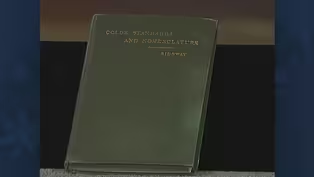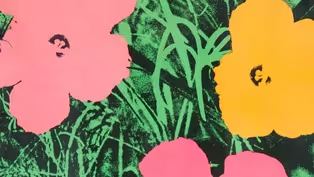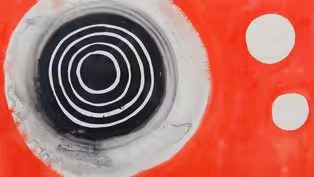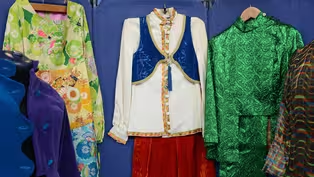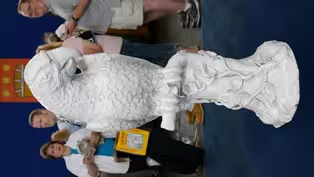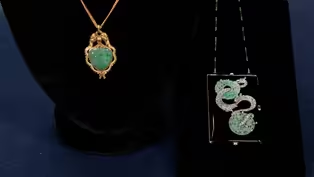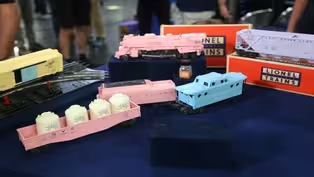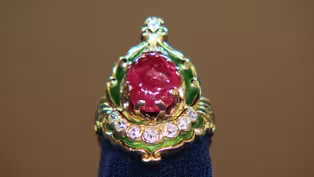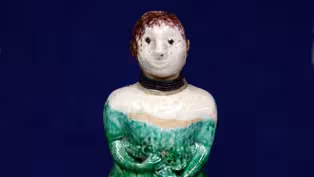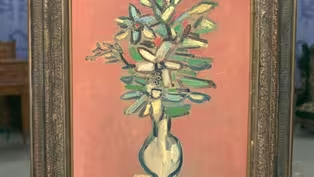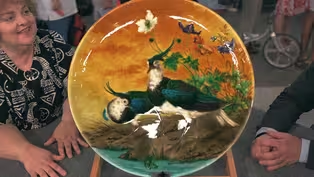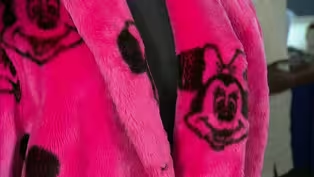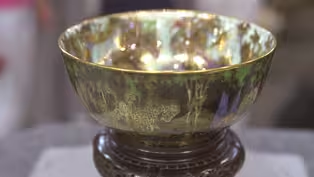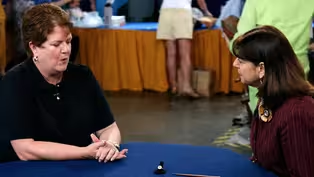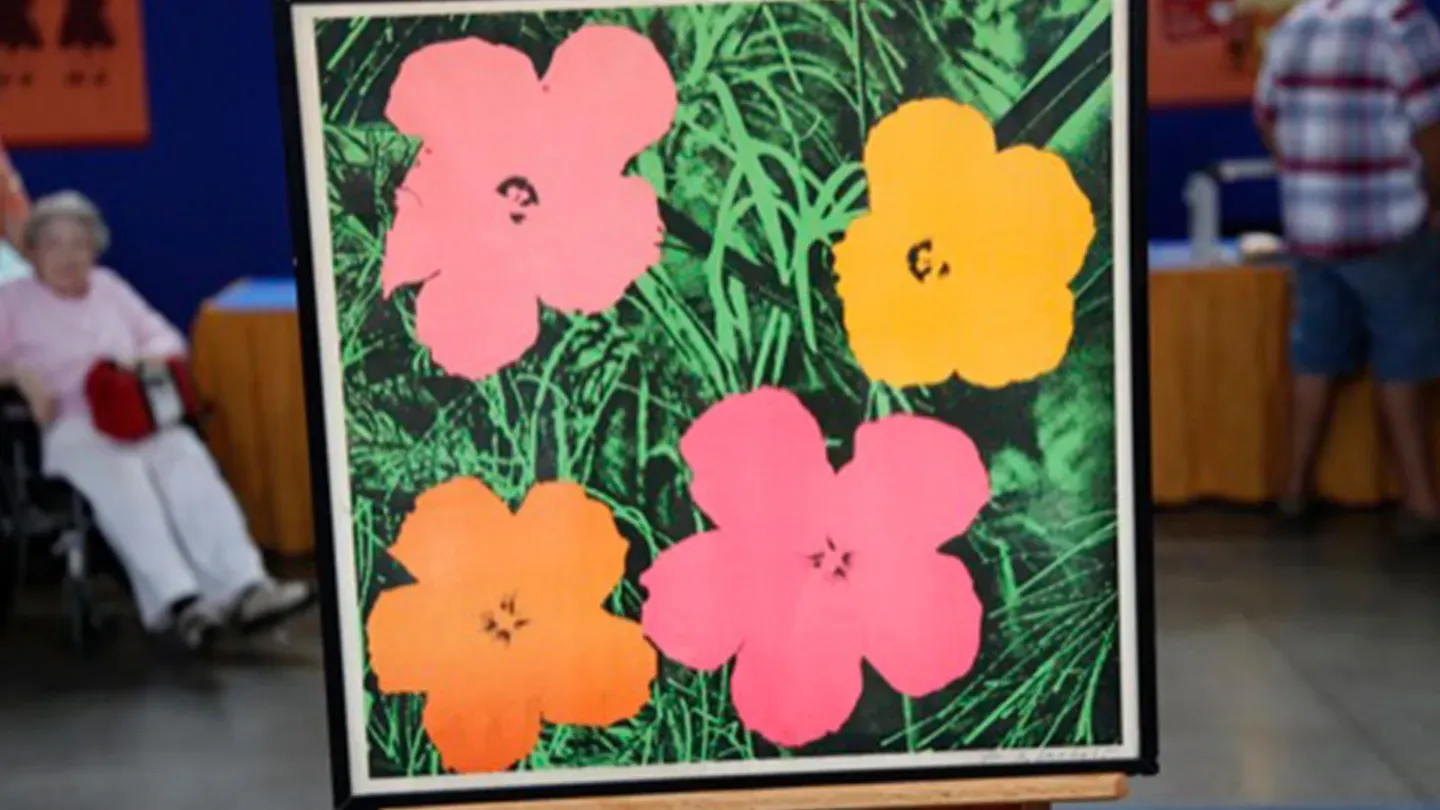

True Colors
Season 25 Episode 24 | 52m 18sVideo has Closed Captions
Feast your eyes on a rainbow of ROADSHOW’s most colorful treasures, including a $100K find
Feast your eyes on a rainbow of ROADSHOW’s most colorful treasures including a 1967 Alexander Calder "Concentric" painting, a blue opaline snake paperweight made around 1850, and a Robert Ridgway "Color Standards” book. One is now valued at $100,000!
Problems playing video? | Closed Captioning Feedback
Problems playing video? | Closed Captioning Feedback
Funding for ANTIQUES ROADSHOW is provided by Ancestry and American Cruise Lines. Additional funding is provided by public television viewers.

True Colors
Season 25 Episode 24 | 52m 18sVideo has Closed Captions
Feast your eyes on a rainbow of ROADSHOW’s most colorful treasures including a 1967 Alexander Calder "Concentric" painting, a blue opaline snake paperweight made around 1850, and a Robert Ridgway "Color Standards” book. One is now valued at $100,000!
Problems playing video? | Closed Captioning Feedback
How to Watch Antiques Roadshow
Antiques Roadshow is available to stream on pbs.org and the free PBS App, available on iPhone, Apple TV, Android TV, Android smartphones, Amazon Fire TV, Amazon Fire Tablet, Roku, Samsung Smart TV, and Vizio.
Buy Now

ANTIQUES ROADSHOW 2025 Tour!
Enter now for a chance to win free tickets to ANTIQUES ROADSHOW's 2025 Tour! Plus, see which cities we're headed to!Providing Support for PBS.org
Learn Moreabout PBS online sponsorship♪ ♪ CORAL PEÑA: "Antiques Roadshow" has put together a rainbow collection of some of the most colorful treasures we've ever seen.
Whoa!
No way.
(laughing): Oh, my gosh, wow.
PEÑA: It's "Antiques Roadshow: True Colors."
♪ ♪ The eye-popping pigments of art and collectibles are irresistible.
APPRAISER: It's very simple but powerful.
PEÑA: Electric blues... APPRAISER: It's called the Sparton Bluebird.
It came in this wonderful cobalt blue glass and sometimes also had a peach glass.
PEÑA: Dazzling yellows... APPRAISER: The darker the yellow is, the more valuable.
PEÑA: Luscious pinks... APPRAISER: The colors are as impeccable as I've ever seen them.
PEÑA: We couldn't resist sharing treasures that together make a kaleidoscope of colors.
And some are even over 100 years old, like this one.
Take a look.
WOMAN: It was just in a box of books.
I collect old books, so I looked through it.
I just really was intrigued by all the, the colors and stuff, so I bought it.
APPRAISER: It's called "Color Standards and Color Nomenclature" by Robert Ridgway.
Have you found anything out about Mr. Ridgway?
I couldn't find out anything, so I gave the book to my daughter Ina.
APPRAISER: And?
Yeah, she passed it on to me, and I did a little research and I found out a little bit about the author, and that he was a ornithologist...
Right, he's identified here as curator of the Division of Birds...
Okay, okay.
...United States National Museum.
And I know another book by Ridgway about birds, "Birds of North and Middle America," but I didn't realize he had made this book.
And this book, as he explains in his preface, was really an attempt as a scientist to standardize names of color in a similar way that weights and measures had been standardized.
The beauty of the book are the plates.
BOTH: Yeah.
There's a caution here printed that the plates should not be exposed to light or they could fade, and clearly, they haven't been, because they're beautifully vibrant.
Now, in 1886, Ridgway published a book called "Color Nomenclature for Naturalists"... WOMAN 2: Hm.
...that illustrated 186 colors.
This book has 1,115 colors.
Yes.
Plus, on each page there's, for guidance, control, white and black, as well.
Hm.
So there's over 1,400 pieces of color.
Wow.
All of which had to be cut out and mounted by hand.
You've noticed these aren't printed on the page, but mounted.
Mm-hmm.
Yes.
I'd hate to be painting my house based on these, because you get a whole great variety.
(woman 1 laughs) WOMAN 1: It is hard to choose your favorite one.
Exactly.
But I think we agreed that we both liked purple.
So let's show that.
WOMAN 1: Right, I do like purple.
WOMAN 2: Yes.
The Ridgway color system never caught on.
So this is really, I think, a testament to Ridgway and his tenacity.
No commercial publisher could have taken this on.
I don't know if you've noticed, it was published by the author.
WOMAN 1: Oh, no, I didn't see that.
(woman 2 murmurs) The edition must have been very small, certainly less than 500 copies, and probably closer to 300.
Wow.
So it maybe failed as a scientific work, but I think it succeeds as a work of art.
How much did the box cost?
No, I just bought the one book.
APPRAISER: Okay.
It cost me a dollar.
I would certainly think, in this condition, which is very good, this copy would sell for between $700 and $800.
(laughing): Oh, you're kidding!
Oh, my gosh.
You're kidding!
APPRAISER: I'm not kidding.
Wow.
Oh, my gosh.
And it's an exciting book because of the contents.
I appreciate your bringing it in.
That's amazing.
WOMAN 1: Oh, I can't believe it.
WOMAN 2: Oh, my God.
WOMAN: So it was maybe, like, a few years ago.
My parents live out in the country, a couple of hours from St. Louis, and it was at an estate sale.
Just, I thought it was really cool-looking, the colors.
It was about $200.
APPRAISER: What you have here is an 18-karat yellow gold enamel diamond and ruby ring.
It's from the Art Nouveau period... Mm-hmm.
...and it probably dates to 1905.
Oh.
The ring itself is beautiful for what it is.
Yeah.
For a period ring.
It has a really nice look to it.
I would say, just the ring alone...
Right.
...is worth about $2,000 to $3,000.
Whoa.
But inside is a very clear signature, "Marcus & Co., 18 karat."
And you can see it right here.
Marcus and Company was a very prominent New York maker.
They were founded in 1892 and were around until about 1960.
Herman Marcus immigrated to the United States from Germany in the middle of the 19th century and worked for Tiffany and Company.
He then went off on his own and formed Marcus and Company.
This is very characteristically Marcus.
Ooh.
It's Mughal-designed.
Yeah.
So sort of Indian-inspired, which you can see.
So cool.
The shape looks like a sultan's turban, and the colors and the material, also very Mughal-inspired.
Mm-hmm.
The Art Nouveau period was inspired by nature.
There was a lot of Orientalist interest.
Mm-hmm.
And that's very clear here.
The center stone is a ruby.
It's a cabochon ruby... Oh, okay.
...which means that it's smooth over the top, so not faceted.
And it has a very rich pink hue.
So rubies come in a range of colors from red to pink.
Mm-hmm, mm-hmm.
The pinker saturated rubies, like this, are most often from Burma.
Okay.
So this I would characterize as a Burmese ruby.
Okay.
Because it was made by Marcus and Co., that makes me that much more certain that it is indeed a Burmese ruby.
Oh, okay.
Because they would be using the highest quality of goods available to them at the time.
Sure-- ooh, yeah.
Historically, with trade between Burma and the rest of the world... Mm-hmm.
Burmese rubies couldn't be exported.
Exported.
So there was a hold on them.
Right.
Therefore, there aren't very many of them on the marketplace today.
The gorgeous green enamel work...
I love that.
...is also very characteristic of Marcus and Company.
They were enamel masters.
Yeah, they're...
There are beautiful, very bright diamonds, really used as accent stones, also common for Marcus and Co. for the day.
Okay.
I would say, at auction today, it would be worth between $7,000 and $10,000.
Whoa!
No way!
Oh, my gosh.
Wow.
Whoa, I got chills.
So I'd say that was a pretty good buy.
(both laugh) It does have a chip.
Because of what it is, the chip doesn't make it worth any less.
Thank you.
Of course!
Day-maker!
(both laughing) Got to insure that, honey.
Yeah, absolutely, and for insurance, often double.
Okay.
Yeah?
I mean, I would say for an insurance value, closer to $20,000 would be reasonable.
Wow.
WOMAN: All I know is that my brother owned it.
He loved art glass, and my mother now has it in her collection of paperweights.
It's interesting, because it would really fall more into the category of, of paperweights than art glass.
It is French, and the blue glass is called opaline.
Now, the French did lots of opaline.
You find blue opaline, and green and pink and white.
The three major French crystal houses-- Baccarat, Saint-Louis, and Clichy, who worked in the 19th century-- all produced this type of glass.
This would have been made during the classic period that the French did paperweights, which is the 1840s to '60s.
Normally, you would find a white goblet or decanter, and they would take the blue glass and coil it around as a snake and do it on the outside of a form.
Oh, okay.
But here, they actually coiled the glass and made a three-dimensional snake paperweight as an individual object.
Now, that's very unusual.
And the top of it is, is beautifully gilded.
And if you look from the bottom, what you have is just the, the opaline.
So it's a blue glass with a nice shine, and it's a great color.
I think that's why we all love it, is the color.
There is one example of a salamander done by Pantin that isn't free-forming.
Otherwise, I haven't seen an opaline animal.
Really?
In this timeframe, you would not expect it to be marked.
If it was marked, you'd be suspicious.
It was not something that the French did.
But it is a most unusual item.
If it was a nice coiled snake on a goblet, it would be a few hundred dollars.
But just the coiled snake, gilded, as a paperweight itself, I would put a value of about $2,500 to $3,500 on it right now.
Oh!
How exciting.
(laughs) It's a great thing, and it's really a marvelous piece of French 19th-century glass.
And I want to thank you for bringing it in.
Well, thank you very much, and now we're all going to be fighting over the snake, so thank you.
APPRAISER: They are paper dresses.
They were first started in 1966, and they were popular for a few years.
You could wear them once or twice and then you just threw them away.
This one is, is quite fabulous, because it's got that whole '60s... Yeah.
...op-art, wavy, psychedelic look to it.
Uh-huh.
And this one is a fabulous color combination, the bright electric blue and the turquoise.
Yeah.
This is one of the more collectible Sandwich Glass pieces that you find on the market.
The amethyst color is very, very desirable.
It dates from about 1820 to 1840.
Usually, the stopper is lost or broken.
(woman laughs) This is not, which makes it very unusual.
APPRAISER: It's one of the most recognizable radios that exists.
It's called the Sparton Bluebird.
It came in this wonderful cobalt blue glass, and sometimes also had a peach glass.
In the '30s, a lot of radio companies hired industrial designers to do their work, and this particular one was designed by Walter Dorwin Teague, who was known for working for Kodak, who did some cameras, and he also designed the interior of the Boeing 707.
This coat belonged to my mother.
I happened to inherit it.
She used to work in fashion advertising design back in Chicago, and she was a big fan of Disney.
And this coat was the centerpiece in her wardrobe and her collection for years and years and years.
My guess is probably the '70s, late '70s, early '80s.
Just because I remember it, growing up as a child.
Well, she didn't buy it in the '70s.
Ah.
Because it wasn't made until the early '80s.
Oh, okay.
And actually, one of the big signs that tell us is this great big sleeve with the padded shoulder.
Right.
That didn't come in till the '80s, and it was a hot commodity in the '80s.
The look, actually, the padded shoulder, came from the military look of the '40s... Oh.
...where the women had the large padded shoulders, like Joan Crawford.
This coat is high fashion for the '80s... (chuckling): Okay.
...with a real Disney swing, and I love it.
Oh, yeah.
I love the fabric.
I love the pink.
And it is not real fur, it's just a faux fur.
Okay.
It's French fabric.
It's from Walt Disney Productions.
It's a great design.
It's really soft, isn't it?
Yeah, it's very soft.
Have you ever worn it yourself?
I have, yeah.
A couple of times, yeah.
Oh, I can see you in it.
(laughs) Well, I've never seen another version in pink, and when you pulled it out of the bag, I was just blown away by it, because it's just so insanely wonderful.
Currently, in the vintage market, they're selling anywhere from $500 to $800 each, so... Oh, wow.
Good, wow, that's great.
WOMAN: I brought my grandmother's necklace.
She brought it from China.
She came to the U.S. in 1923.
And then this I bought on an online auction about four years ago.
You know about this particular piece, it's high-karat gold.
Right.
It's, like, 22-, 23-karat gold.
Uh-huh.
And the carving of the jade in this heart is jadeite.
And it's a little mottled, but it's a new piece; it's not old.
I mean, it has to be 100 years old before it's old.
Yes.
Now, you brought me another piece here.
Yeah.
And do you ever use this?
No, I have not.
You know it's a compact.
Yes, I do, I do know it's a compact.
It's a two-stage compact, there's two compartments, with a mirror.
Your two pieces of jade are broken.
Oh, are they?
Yeah.
Uh-huh.
This one has a slight crack in it and the top over here is missing, see?
Oh.
They were representative Han Dynasty coins: the double carving, on both sides.
Yes.
And Han Dynasty coins had holes in the middle.
Now, those were good luck jade for that particular period of time.
Mm-hmm.
What I like about this compact is, the whole gold case is made from green gold, and that's very hard to do, and very rare.
Really?
The gentleman who made this, which is not marked, knew what he was doing, because enamel adheres to green gold much better than yellow gold.
Oh.
And this is all black enamel, even on the back.
Your chain is platinum.
I don't think it really belongs on this piece, but it's a magnificent two-tone platinum chain.
Now, how much did you pay for this?
$1,200.
Your jadeite piece over here would bring anywhere from $1,000 to $1,200 at auction.
Oh, okay.
Your compact, at auction, could easily go anywhere from $12,000 to $15,000.
(gasps): No kidding!
(laughs) Oh, my God!
I don't believe it.
Oh, my God, really?
It's...
I don't, I don't believe it.
That's-- my God.
Enjoy it.
Thank you.
WOMAN: It was given to me by a friend.
He's from the Seattle area.
He was in a little shop, and there was a bunch of rolled-up posters in a bin, and, um, he just liked it.
Probably paid a few dollars for it, and that's really all I know.
So you're asking me to appraise a gift.
I am.
So maybe I could cause some friction between you and your friend, depending on how the appraisal goes?
Actually, he's a very dear friend and a co-worker, and when I was gonna bring it, I told him if it was worth much, I'd split it with him.
That actually sounds very fair.
So I'm saying this on camera.
(laughs) The obvious thing is, it's advertising TWA flights to New York City.
The artist signs his name "David."
His full name is actually David Klein.
Okay.
Now, David Klein was a very prolific artist who worked for TWA.
Oh.
This is one of the more recognizable and one of the more popular images that he designed.
Really?
And in my opinion, it is one of the greatest graphic depictions of Times Square.
It's a geometric, abstract, almost kaleidoscopic view...
Yes.
...of this great bustling intersection.
He captures all of the energy, he captures all of the excitement, he captures all of the movement.
It was done in 1956.
It is part silk screen and part photo lithograph.
The bright colors have been put on through a silkscreen process...
Okay.
...and everything else has been printed via a lithographic process.
One of the other great things about the poster is the plane that's on top.
The plane is the TWA Lockheed Constellation, known as the Connie.
They were considered great airplanes.
Okay.
You see, it was a propeller plane, there's the propellers on it.
Right.
And with these planes, TWA was able to initiate full service to Europe.
Now, I'm not the only one who likes this poster.
The company liked it so much that they continued to reuse it in subsequent years.
But there's one way that we can tell that this is the original printing and not a later printing, and that is the airplane itself, because shortly after 1956, propeller planes were phased out and jet planes were phased in.
So subsequent printings of this poster don't show the detailed Constellation.
Ohhh.
They show the silhouette of a jet plane actually leaving a vapor trail behind it as it goes across.
Oh, my goodness.
Not only was the company very fond of this poster, but this poster is also in the permanent collection of the Museum of Modern Art in New York, MoMA.
Really?
So really, the poster has a lot of fans.
So it was a gift.
It was a gift.
And I don't want to cause a rift between you and your friend.
You couldn't.
But at auction, I would estimate this piece between $2,500 and $3,500.
(gasps): Oh, my gosh, you're... Oh, he's gonna be so thrilled.
Oh, my gosh.
And we have you on camera saying you would split the price with him.
Yes, I told him I would.
WOMAN: This painting is my mother's, and she was a personal friend of René Portocarrero back in, uh, in the late '50s, when we lived in Cuba.
She had immigrated from Holland and quickly got to know them.
She also paints.
When she saw this painting, was in their studio.
It was still wet, it was on the easel, and she said, "I have to have that."
And he was very excited that she loved it.
And, um, they went all over the old part of Havana to all the flea markets just to pick this particular frame, which, you cannot really see the colors that he had put into it when he had this picked for it.
She's had it ever since.
She has several paintings by him.
We don't know any values, because they are just, they were gifts to her.
Exactly.
So... René Portocarrero is one of the several artists who is absolutely crucial for the development of Modernism in Cuba.
And that was beginning in the 19... Late 1920s and 1930s, actually.
Mm-hmm.
And he, along with other artists named Amelia Peláez, Mario Carreño, uh, to name a few, were responsible for making an absolute break from European Modernism, and what they did is basically start painting scenes that were endemic to Cuba.
And in addition to that, they were using bright colors, and you can notice in this brightly colored composition that the artist has used some almost fauve colors.
And he also is very, very lavish with his application of paint.
Right.
You can see, in the, in the petals of the flowers, a great deal of impasto.
It's funny that you mention that he and your mom went out to the, to the flea markets to, to search for frames.
He adored putting baroque frames on his paintings, and once he would find a matching frame for the painting... Uh-huh.
...would add his own personal touch by adding certain pigments.
And this, and in this particular case, green and white paint into the floral part of the frame.
The market for Cuban paintings has really become very hot in the last number of years, basically because the growing number of Cuban émigrés into this country are interested in trying to reclaim some of their national patrimony, or their artistic patrimony.
Right.
And we have enjoyed a rise in his prices.
We think that this painting is worth in the vicinity of $18,000 to $22,000.
My goodness, that's wonderful.
WOMAN: It was my grandmother's, and they called it a doll.
She said that it was her great-grandmother's doll.
My great-great-great-grandmother lived in North Carolina, but at some point, they traveled out to Missouri and then came back to North Carolina.
And that's really all the history I have on the doll.
And where in North Carolina were they from?
Winston-Salem.
That's a great little heirloom, and what do you do with it now?
Dust it.
Yeah?
That's about it.
Yeah?
And the story is that your grandmother used this as a toy?
She played with it.
Wow.
She played with it, and we don't know why there's a hole in the head.
I don't know if there used to be another type of hair coming out or what, but...
Okay.
When you told me that your family was from Winston-Salem, that was one of the clues to help me identify this little flask.
Okay.
And... Oh, you're...
This is a very rare bottle.
Ooh.
It was made by Moravian potters.
Right.
In Salem, North Carolina.
Salem was the center of Southern pottery making.
The industry began there in the mid-18th century.
But this style of bottle was made in the first couple of decades of the 19th century.
Okay.
This was probably made 1810 to 1830.
Wow, wow.
Whether they were used for spirits or whatever, but the hole...
Right.
...is where a cork was.
Okay.
So it was not a doll.
(laughs) Oh... (laughs) Okay.
It was actually used to store liquid in.
The Moravian potters of Salem, or what's commonly known today as Old Salem...
Right.
...made a number of forms like this.
Uh-huh.
They made a squirrel holding a nut, a fish, a turtle.
Right.
The doll is probably the one you see more often than anything.
Mm-hmm.
The necklace somebody added.
Yes, I think my grandmother did that.
Somebody...
Your... She was very handy.
And although it's really hard to see when you look at her crossed hands, she's holding a little bouquet of flowers.
When you look at the side... See the mark here?
The little, the vertical mark here?
Yeah, uh-huh.
This was made in a mold, in a pressed mold.
Okay.
So the clay was put together, then they pushed the mold together to make it.
It was not a hand-thrown bottle, it was a mold-made flask.
These are very collectible and very desirable.
Ooh... Have you ever had anybody look at it and say, "Hey, I'd like to buy that from you" or anything?
No, uh-uh.
This flask would sell at auction for between $15,000 and $25,000.
(inhales sharply) That's amazing-- God!
So I'll, I'll keep on dusting it.
Maybe I'll put it away so it doesn't get dusted.
(chuckles) APPRAISER: It's a tea cozy and it fit over a big teapot.
The biggest one I've ever seen.
This is from the eastern side of the Great Lakes, probably made between 1880 and 1910.
This has got to be the most spectacular piece of, of beadwork from the Great Lakes I have ever seen in my life.
I mean, this is just over the top.
APPRAISER: This is called a Bakelite cherry pin.
Bakelite was patented about 1908, and it was a very durable plastic, and today, it's very collectible.
APPRAISER: It's completely done in black enamel and all the way around the watch-- on the sides, everywhere-- it's studded with hundreds of rose-cut diamonds.
The watch would have been made somewhere around 1900.
This is a triple-signed watch, which means that the dial is signed "Tiffany and Company."
Okay.
The movement is signed "Tiffany and Company, New York," and the case is signed "Tiffany and Company."
Okay.
The watch is just absolutely drop-dead gorgeous.
The decoration is what we call Fairyland Lustre.
And in fact, there are fairies and gnomes that surround the inside of the bowl.
Right.
The background color, because it's orange, we call it Flame Fairyland.
Now, Wedgwood produced this in bone china in the 1920s.
This has a number of wonderful characteristics for it.
First, it's not a typical bowl, but it, it's a footed bowl.
Next, you see the little elves on the outside, and they're leapfrogging, and this particular pattern is actually called Leapfrogging Elves.
It's got this wonderful verse around the outside.
Yes.
And I was looking to see where it began, and actually, I think I found it.
It says, "Gray for the goblins, blue for the elves, "brown for the little gnomes that live by themselves, "white for the pixies that dance upon the green, but where shall I find me a robe for the queen?"
Yes.
It's wonderful.
Signed on the bottom with the Wedgwood, and this is the bone china mark that one would have expected for it to be manufactured about 1920.
Now, these were designed initially by a lady called Daisy Makeig-Jones, and she just had wonderful imagination, but seldom do we get signed pieces of Daisy.
This piece is signed in the rocks.
"M.J." Oh, yes, uh-huh.
We almost never find them.
That, and the fact that it's in perfect condition, on the market today, I would expect it to bring anywhere from $7,500 to $10,000.
Oh, that's wonderful.
WOMAN: A friend in Sacramento was a collector of Pop Art in the '60s.
APPRAISER: Uh-huh.
And she acquired some lithographs of Warhol and asked me if I'd like to buy one.
And I said yes, and I don't think I paid a great deal for it at the time.
What would "not a great deal" be?
Do you think it's-- did you, would you have spent more than a few hundred dollars on this, do you think?
Oh, $25 to $30.
Okay.
And this was back in the, in the late '60s?
'65, somewhere there.
Okay.
It's a print by Warhol, and you can see the signature in ink.
Right.
And the date, "65" for 1965.
This is one of his classic early images produced as an announcement for an exhibition at the Leo Castelli Gallery in New York.
It was an exhibition of his flower paintings.
So, larger-sized canvas paintings.
This announcement, as an offset color lithograph, was used in the gallery for clients, people coming into the exhibition, and it was issued two ways: both hand-signed by him and unsigned.
Unsigned, oftentimes, it was folded into four and used as a mailer.
There were only about 300 of these that were hand-signed by the artist.
Warhol was known for appropriating popular images and turning them into art.
You might think of the soup cans, the Brillo boxes, all these everyday things that he made into fine art.
And this is some of the earliest example of that.
What you have is one of the real classic Warhol images from the earliest part of his career as a Pop artist.
It's a photograph that he found in "Popular Photography" of hibiscus flowers, which he then added the color to.
And it's very sort of 1960s colors.
Yours happens to be in very good shape.
The colors are as impeccable as I've ever seen them.
You have a little bit of staining down here, which shows best on the orange flower, but the water staining is entirely reversible, and the signature is a wonderful, strong signature.
Sometimes that's faded, too, because it's a ballpoint pen and ink.
If I had to rate this condition-wise out of ten, ten being the best, you're at, like, nine-and-a-half.
Really?
Great.
For what we normally see on the market.
A conservative replacement value on this, if you were to go out and buy it now, would be in the neighborhood of about $30,000 to $40,000.
You're joking.
(chuckling): No.
Oh, my God.
This was my grandfather's.
It was given to him during my father's birth in 1925.
I appropriated it from my father about 1968, and it's been in my home ever since.
The material is porcelain, as opposed to pottery or clay.
And we can tell that-- and I'll put my glasses on, because I can't see.
When you flip it over, the sort of white color that you get here, that is the porcelain clay, the actual color.
Now, the mark that's there tells us when it was made and where it was made.
More importantly for the moment is the glaze itself.
This is a very specific type of glaze made in Asia, and it's called flambé, which is a French word, and it just refers to this sort of mixture of beautiful turquoises, the sky blue, with this deep, rich red, sort of ox blood kind of a color.
And you'll also notice, on the surface, there's lots of little pits.
Mm-hmm.
That's characteristic of this particular type of glaze.
Now, this glaze is imitating a specific type of material first appearing in the 12th- 13th century in China, during the Song Dynasty.
It was copied at a later date.
Now, the later date this was copied was during the 18th century.
And that mark I showed you on the bottom... Mm-hmm.
...actually indicates that this was made between 1736 and 1795.
Oh, my God.
It also says that it was made for the imperial household of China.
Oh, my God.
Those are all wonderful things.
The pitting, the color, the sort of green tinge around the top, the shape is called a meiping-- all those things verify that this is authentic.
Wow.
It's real.
It's beautiful.
It's a very special object.
It has one problem.
And I'm gonna spin it around, and you've mentioned it to me.
It's got a little bit of a line down through the glaze.
That's called a glaze crack.
Mm-hmm.
And it probably came because somebody whacked the side of it with another hard object.
So would you like to know the sales value or sort of the insurance value, or does it matter?
The insurance value, because I have a feeling I'm probably gonna have to do that.
You have a treasure from the Qing Dynasty, the Qianlong period.
I would insure this for... $40,000.
(breathlessly): Oh, my God.
If it didn't have that line, I would insure it for $75,000.
Wow.
WOMAN: Well, we've always been big Packer fans in my family, and my parents had a first row seats at the Ice Bowl, about the 30-yard line.
And after the game, my dad brought this home.
He brought it home.
It was his souvenir from the Ice Bowl.
Yes.
So, to set the scene, the Ice Bowl was played on December 31, 1967, and it was the Green Bay Packers against the Dallas Cowboys, and this was the NFL championship game.
So it was a really big game.
Yes.
In fact, many consider it the most important of the year, even though the NFL winner would go on to play in the Super Bowl against the winner of the AFL.
Now, what does your dad, what does he remember about the game?
It was very cold, it was 13 below zero, and it was very exciting because it came down to the last play of the game.
Mm-hmm.
And Jerry Kramer blocked for Bart Starr so they could get that touchdown.
This is not only considered to be one of the greatest games of all time, but one of the coldest games.
So the temperature was minus 13 degrees, and with the wind chill, it was minus 48.
Now, I know Green Bay fans are hardy fans, but how do you handle 48 degrees below zero?
Well, I think it was hardest for my mom, because my mom didn't have long underwear.
(chuckles) And of course, you dressed up to go to these games.
So it was very, very cold.
And I just remember her coming home just frozen to the bone.
In that game, the band actually had their mouthpieces frozen to their lips, and even the officials had their whistles that froze.
They couldn't use their whistles; they had to yell during the game, it was so cold.
But beyond that, it was one of the most exciting games ever, because with 16 seconds left in the game, you've got the Cowboys up 17 to 14.
And what are the Packers going to do?
And you're on this-- and what's known today as the Frozen Tundra.
Yes.
They described it as like a hockey rink, like a sheet of ice.
And what do they do?
They go to Jerry Kramer, who signed right here, one of the great offensive linemen of all time, and they go to a quarterback sneak.
And Bart goes right behind Jerry, sneaks into the end zone, and they score the winning touchdown, 21 to 17.
So does your dad remember what it was like right after the game, what it was like when they won?
Because, I mean, it's a last-second win, it's pandemonium.
What was going on on the field?
A lot of the fans rushed the field and they took down the goalpost.
So while they were doing that, my dad went and got tools so that he could bring this home.
They were screwed in around the stadium.
Right.
And, and no one stopped him.
No.
Were other people taking the other signs, as well?
Yes, but most of them were just ripping it off.
Right.
Whereas he went out to his car and got tools so that he could take it off in one piece.
You've got Kramer signed here.
And by the way, Doug Hart was a great defensive back.
also.
Yes.
Did your dad get these signed?
No, my husband and I and our son took it to a signing, and Jerry signed it, and also Doug was there.
Oh... And this is the play that was called.
They were quite impressed that we had it.
(chuckles) And were very delighted to sign it.
Stadium artifacts are extremely collectible, and in the 1990s and 2000s, there have been a number of stadiums-- the Boston Garden, Busch Stadium-- that have been torn down.
Right.
Tiger Stadium.
And collectors go and buy these artifacts.
And I got to tell you, I think it would be at least $3,000 to $5,000.
Oh, wow.
(chuckles) And I just want to thank you for bringing the coolest piece possible into the Roadshow.
Thank you.
My mother had a beige apartment, and she hated the color beige.
So she asked an interior decorator to give her an idea of what to do.
He told her to paint all the walls this bright color, and then he went to England and he called her on the phone and said, "Guess what?
I found a plate that will match the apartment's color."
And so, sight unseen, my mother purchased this plate.
APPRAISER: You had also shown this to someone and they had given you some information.
What do you believe that it is?
What is your, what is your thought on this?
Well, it had an age crack on the back of it, and in order to get it repaired.
we took it to a museum to get it checked out and fixed.
And they said yes, it was definitely a very old plate, and I was told eventually, it came from a castle in England and it was about in the 1750s or so, but we weren't really sure.
And your family ate hamburger for a while while they paid this off.
(chuckling): Oh.
Mom didn't have a lot of money to pay for this, so she was taking it out of her allowance, and that's what happened.
Well, certainly this plate has almost every color that you could possibly imagine.
It is a plate that is actually made in France, and probably in and around 1885.
There was a very famous French art potter by the name of Théodore Deck, and he was the head of the porcelain manufactory at Sèvres, which is a very important factory in France.
He was also supplying designs to Wedgwood a little earlier than that, but he was famous for his Japanese designs.
And you can actually see that transitionally, you've got these birds here, which are sort of very Japanese in quality, and yet you have these incredibly beautiful flowers that are coming out in these marvelous colors of purple and rust and white.
And so you get that really marvelous flowing Art Nouveau influence.
And it's actually signed right down here by the artist, which is Ernest Carrière, and Ernest Carrière... Actually, you can also see how he's layered these enamels and really done a fantastic job.
We know that it's Deck because there's a stamp on the back...
Right.
...and actually the stamp of the Sèvres factory.
But to integrate all of these designs together with this marvelous frog down here at the bottom.
(laughing): Don't you love him?
And the size of it is just everything you want to see.
Great.
It was spectacular then, it's spectacular now.
Yeah.
An almost identical piece sold not too long ago-- identical-- for $17,000.
Wow.
And with the crack on this, I would say it's probably worth around $12,000 to $15,000.
Wow, that's wonderful.
Thank you very much.
My pleasure.
I love it!
Thanks for bringing it in.
There are very, very few examples of neon signs being created in the 1930s for interior advertising purposes.
It was usually used for building signage, for store signage outside.
APPRAISER: It's got a mark on the bottom for the Teco Pottery, which was made outside of Chicago.
They say "tee-co." Really?
But I always call it "teh-co," because it's short for terra cotta.
This would have been made around 1905.
This is in absolutely perfect condition.
It has this stitching, but it also has these little dots here, which turn out to be lights.
And on the back, it's got, uh, some wiring here that creates a light display, and that was very typical of works in the '70s and '80s, where artists were going beyond just working on a flat plane.
Well, when I was a little girl, I kept asking Santa Claus each year for a Lionel train.
It took me three times before the old elf came through and he brought me a pastel girl's train.
I would put my hamsters in the box cars and I would set my parakeet on the, the hopper car there, and we'd go round and around the track.
We had a wonderful time with our train.
After the war, Lionel's trains weren't selling that well, so they were looking for all kinds of ways to boost sales.
And one of the ways, they figured if they could get little girls to do, like trains, that would be a help.
It wasn't that successful, which is why these are fairly rare.
A set like this, in the original box, at one point was bringing in as much as $10,000.
Ooh.
Now it's down to around $2,000 to $3,000.
But still, it's a pretty nice price for a set like this.
Thank you very much.
Well, thank you for bringing it in.
WOMAN: This was left to me by my mother from her mother.
APPRAISER: Do you wear it?
Not often.
Not often.
Do you think it's real?
Yes, I've been told that.
You've been told it's real, okay.
Well, you know what?
You were told correctly.
The original cut was around 1902 by a man named Joseph Asscher.
He invented this particular cut, and when he invented it, it was unique.
It was different.
It's always kind of octagon shape.
It almost looks like a hall of mirrors-- it reflects.
It is actually a precursor to the emerald cut.
And this became very popular cut in the '20s and '30s, and then it just went out of fashion.
And now it is the hottest thing in the diamond market.
But what makes this very unusual is the color: it's yellow.
Yeah.
We called it a canary diamond, that's what they called it.
That was, that was the term that was used.
Uh-huh.
But we know more now, and we don't use that term anymore.
Oh.
We actually look at it and decide how intense the color is.
Okay.
Now, it's hard to judge that intensity in the mounting.
So most people that have yellow diamonds like to know exactly, is it a fancy intense?
Is it a light fancy, is it a vivid?
And the darker the yellow is, the more valuable.
The hard thing about this diamond is to measure it, because it has so many facets and cuts.
I came up with around 3.20, 3.25 carats.
Mm-hmm.
But that's an important size for an Asscher cut for a yellow diamond.
It's very hard to get that combination.
I've had only one small one in 26 years in the business.
So that tells you it's rare.
Yeah, okay.
The cut of that could have been as early as 1902.
Mm-hmm.
I don't think so, I think it's probably from the '30s.
The diamond is set in a platinum, pierced mounting.
Mm-hmm.
It's very delicate, and it actually looks like the four prongs have been remounted.
Which makes sense, because after many years, it would loosen.
Yeah.
But it's a lovely setting for that type of stone.
Unfortunately, I don't know the maker of the mounting who put this together.
Do you have any idea where it might have originated from?
New York City.
Okay.
But the value, that's the hardest thing to put on this.
Yeah.
Is because we don't know exactly the color.
My feeling is that this could translate to a fancy intense.
Really?
And that makes it quite valuable.
And I'm going to be very conservative.
I would say at auction today, $75,000 to $100,000.
Oh, my God, you're kidding me.
No, I'm not kidding.
(laughs) And I'm being conservative.
Are you surprised?
Yes, shocked.
I can't... Well, I'm not gonna wear it.
Why not?
Wear it!
Because I'm a teacher.
You're a teacher, oh, that's so good.
Where am I going to wear it, to the grocery store?
WOMAN: I love going to thrift shops and consignment shops and treasure hunting, And my husband and I walked into a consignment shop, and I saw Parrot, and I had to have him.
He was just amazing.
APPRAISER: Here in Philadelphia?
Right outside of Philadelphia.
And how much did you pay for this one?
$50.
How long ago did you buy him?
About two or three years.
He was modeled in Italy.
It's hard to date him exactly, but he's early 20th century.
There's a tradition in Continental Europe of modeling large-scale birds and animals in ceramic, which dates back really to the Meissen Porcelain Works almost 300 years ago, where they made full-scale figures of animals and larger.
But he's not made in porcelain, he's made in what they call in Italy maiolica ware, and maiolica is generically termed tin-glazed earthenware.
Now, all the colors in ceramics come from the action of metals or minerals that oxidize when they're being fired, and tin, when it oxidizes, clouds white.
So it became a very successful way of covering a piece of earthenware to make it white or effectively to make it look like porcelain.
You can see, just in a few little spots where the glaze hasn't taken, you can see the natural color of the earthenware underneath, which is kind of a, a brick red color.
There's a chip down here where you can see a larger section of it, and that identifies it as most likely Italian, or certainly Mediterranean-made.
This is not a piece that we're going to be able to identify the manufacturer, the modeler, even the date, precisely.
But it doesn't really matter who modeled it or where and when it was made, because the value is as a decorative object.
And if someone wants a very large white earthenware figure of a parrot, here it is.
And it's not an easy thing to find.
I think if this was in an antique shop, you could certainly put a price on this of $2,000, and I don't think that would be unreasonable.
No, that's great.
We all loved him when you brought him to the table.
You know, wow, I mean, he's quite an eyeful.
When my dad, who was a rancher, retired, he began to speculate in the stock market.
And he made a lot of money.
My mother and I, you know, we were kind of in the background.
But she wanted to make one investment, and so he, he said, "Okay."
We bought it in Houston, brought it home, and we were just the laughingstock of the family.
My memory is, we spent $2,000, but I think the receipt shows a little less than that.
All the money's gone, but I'm hoping that this is maybe a pretty good investment.
So this is the one thing that you have left from all the... From everything.
All the investments.
Right.
Why did you decide to buy this painting as an investment?
We were at a gallery, and we looked at many things.
But Mother and I both liked Calder; we knew Calder.
But you also bought it because you liked it.
Oh, yes.
Yep.
Mother and I were having fun.
Right.
I always like to tell people not to buy for investment, but because you love something.
And then if the bottom should fall out of the market, at least you've still got something that you love.
Yes.
Well, Calder was born in 1898.
His career began in the '20s.
And by 1926, he had moved to Paris.
And about four years later, he went to visit the studio of Mondrian, who was known, famous and known for his abstract paintings.
And on one wall of the studio, there were these rectangles of colored paper that he would rearrange and shift around and study and decide how he would make his next composition.
And this really impressed Calder.
And he said later in life that this really shocked him towards abstraction.
And for three weeks after that visit, he did nothing but paint abstract paintings.
He ultimately decided that he preferred being a sculptor, but he did always paint throughout his career.
And when you look at his paintings from the '40s to the '70s, you see similar characteristics, which are geometric shapes, bright colors, bold design.
And I think you can see that we have a lot of the things here.
We only have the one color of red, and we have these concentric circles boldly defined in black and white.
Here, he's done kind of a wash to create a gray with the watered-down black.
But it really is a very dramatic composition.
Uh-huh.
It's very simple, but powerful.
When I started out in the auction market in the '70s, these things really didn't bring much money at all.
They hit kind of peak in 2006, and it's leveled out a bit more.
But, you know, they're much more desirable than they were 30 years ago.
Do you want to make a, a stab at what you think the current value might be?
(chuckles): No.
No, you just tell me.
(laughing) Well, I think this is an investment that did work out.
That worked?
That worked!
Because I think if you were going to sell this in a retail gallery now, it, it might sell for about $50,000.
(laughing) I'd say that was a good investment.
That was a good investment.
(laughing): It was.
WOMAN: I brought these pieces from the Beatles' Apple Boutique.
I was there in 1968 in London.
I got homesick and decided to spend all my money and get these clothes and come home early.
So you chose clothes over staying in London?
I was there for six weeks, and I, I was gonna stay another month, but I just fell in love with the clothes.
The clothes you bought are completely iconic from the late '60s.
Do you know anything about the Apple Boutique?
Yes, I was there when it had only been open for a few weeks.
It was open for seven months, I think, before they closed it.
That's right.
They were open in December, they had a big party-- Pattie Harrison, Eric Clapton, a lot of the pop icons of the time were there.
This was the first business venture of the Beatles outside of entertainment.
Yes.
And it's the first actual apple logo that the Beatles used outside of the record world.
And all of your pieces have this fabulous label here, with the psychedelic apple.
The reason the store only existed for seven months was because the people that worked at the store would steal the clothes, the customers would steal the clothes, and the owners, the Beatles, thought it was very uncool... (laughs) ...to complain or do anything about it.
So they were losing money.
Their clothing was designed by The Fool, which was a artistic collective.
Some of the designers were Dutch and some British, and they combined their talents to design clothing.
They also designed the mural that was in front of the shop...
Yes.
...which became very controversial.
Did you see that?
It was-- I did.
It was wild.
It was just very bright and colorful and you couldn't miss it.
Psychedelic.
(laughing): Yes.
Very psychedelic.
Well, they later got in trouble and had to paint it over white.
The clothing you brought is a complete time capsule.
It reminds me of the "Sergeant Pepper" years...
Yes, they do.
...because that's, album had just come out when they were designing these clothes.
Do you remember what you paid for any of them?
For the lot of them, I think I paid close to $500.
If you were to have these pieces at an, auction value today...
They rarely come up on the market.
I've never seen any Apple clothing.
I think this collection would be valued between $15,000 and $17,500.
Wonderful.
Easily.
This dress woven with a very psychedelic pattern and early lurex, which is the sparkly threads, I noticed that it has a tag hanging on it.
Can you tell me about that?
Well, I just realized that I still had the tag until just recently, and I thought...
I never wore this one.
It's just, uh, in, in the closet.
Well, that one actually makes it more valuable, that you haven't worn it.
So that one's probably worth 20% more than the others.
So I, I would put that one at $3,500 to $4,000.
Oh, good, thank you.
PEÑA: Thanks for watching.
See you next time on "Antiques Roadshow."
Appraisal: 18th-Century Flambé Meiping Vase
Video has Closed Captions
Clip: S25 Ep24 | 2m 40s | Appraisal: 18th-Century Flambé Meiping Vase (2m 40s)
Appraisal: 1912 Ridgway "Color Standards"
Video has Closed Captions
Clip: S25 Ep24 | 2m 48s | Appraisal: 1912 Ridgway "Color Standards" (2m 48s)
Appraisal: 1965 Andy Warhol "Flowers" Lithograph
Video has Closed Captions
Clip: S25 Ep24 | 2m 47s | Appraisal: 1965 Andy Warhol "Flowers" Lithograph (2m 47s)
Appraisal: 1967 Alexander Calder "Concentric"
Video has Closed Captions
Clip: S25 Ep24 | 3m 26s | Appraisal: 1967 Alexander Calder "Concentric" (3m 26s)
Appraisal: 1967 Green Bay Packers "Ice Bowl" Sign
Video has Closed Captions
Clip: S25 Ep24 | 3m 54s | Appraisal: 1967 Green Bay Packers "Ice Bowl" Sign (3m 54s)
Appraisal: 1968 Apple Boutique Clothes
Video has Closed Captions
Clip: S25 Ep24 | 3m 10s | Appraisal: 1968 Apple Boutique Clothes (3m 10s)
Appraisal: Blue Opaline Snake Paperweight, ca. 1850
Video has Closed Captions
Clip: S25 Ep24 | 2m 7s | Appraisal: Blue Opaline Snake Paperweight, ca. 1850 (2m 7s)
Appraisal: Chinese Jadeite & Tourmaline Necklace, ca. 1910
Video has Closed Captions
Clip: S25 Ep24 | 59s | Appraisal: Chinese Jadeite & Tourmaline Necklace, ca. 1910 (59s)
Appraisal: Italian Majolica Parrot Sculpture, ca. 1920
Video has Closed Captions
Clip: S25 Ep24 | 2m 21s | Appraisal:Italian Majolica Parrot Sculpture, ca. 1920 (2m 21s)
Appraisal: Jade Pendant & Compact
Video has Closed Captions
Clip: S25 Ep24 | 2m 14s | Appraisal: Jade Pendant & Compact (2m 14s)
Appraisal: Lionel Train Set, ca. 1955
Video has Closed Captions
Clip: S25 Ep24 | 1m 7s | Appraisal: Lionel Train Set, ca. 1955 (1m 7s)
Appraisal: Marcus & Co. Ring, ca. 1905
Video has Closed Captions
Clip: S25 Ep24 | 3m 30s | Appraisal: Marcus & Co. Ring, ca. 1905 (3m 30s)
Appraisal: North Carolina Moravian Flask, ca. 1815
Video has Closed Captions
Clip: S25 Ep24 | 3m 12s | Appraisal: North Carolina Moravian Flask, ca. 1815 (3m 12s)
Appraisal: Peter Marsh Lighting Co. Lamp, ca. 1950
Video has Closed Captions
Clip: S25 Ep24 | 35s | Appraisal: Peter Marsh Lighting Co. Lamp, ca. 1950 (35s)
Appraisal: Rene Portocarrero Painting, ca. 1958
Video has Closed Captions
Clip: S25 Ep24 | 2m 25s | Appraisal: René Portocarrero Painting, ca. 1958 (2m 25s)
Appraisal: Théodore Deck Sèvres Charger, ca. 1885
Video has Closed Captions
Clip: S25 Ep24 | 2m 51s | Appraisal: Théodore Deck Sèvres Charger, ca. 1885 (2m 51s)
Appraisal: Walt Disney Coat, ca. 1985
Video has Closed Captions
Clip: S25 Ep24 | 1m 43s | Appraisal: Walt Disney Coat, ca. 1985 (1m 43s)
Appraisal: Wedgwood Fairyland Lustre Bowl, ca. 1920
Video has Closed Captions
Clip: S25 Ep24 | 1m 42s | Appraisal: Wedgwood Fairyland Lustre Bowl, ca. 1920 (1m 42s)
Appraisal: Yellow Diamond Asscher-cut Ring, ca. 1930
Video has Closed Captions
Clip: S25 Ep24 | 3m 8s | Appraisal: Yellow Diamond Asscher-cut Ring, ca. 1930 (3m 8s)
Providing Support for PBS.org
Learn Moreabout PBS online sponsorshipSupport for PBS provided by:
Funding for ANTIQUES ROADSHOW is provided by Ancestry and American Cruise Lines. Additional funding is provided by public television viewers.


